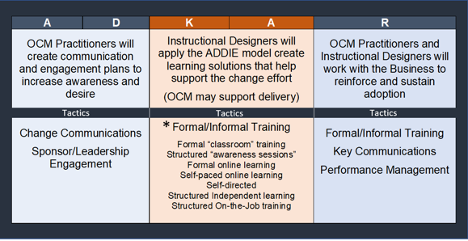Partnering with OCM to Create Training for Adoption
Organizational Change Management (OCM) is best known for preparing people for change. Training plays a key role in preparing people for change and is often required to help people achieve the “new norm.” So, it is critical that Training and OCM teams collaborate and work closely with one another to prepare people for new ways of working. However, it’s not uncommon for these two teams to work not only in different departments, but also under different leadership, often resulting in the two teams working in silos.
We sat down with Donna Martin, an OCM practitioner with 20 years of Talent Development experience, to get her take on how Training and Change Management Teams should partner to create one, cohesive change management strategy.
The collective goal of Training and Change Management is to ensure end user adoption, but they use different models. While ADKAR is often used to manage change, the ADDIE model is the most recognized model for designing and developing training to close knowledge and skill gaps.
How do Training and OCM overlap?
ADKAR is one of the most popular models used to help move people through change. Each letter represents a “lever” OCM Practitioners can use to support people through organizational changes. ADKAR stands for:
build Awareness (of the need for change)
build Desire (to participate in the change)
increase Knowledge (information)
increase Ability (skills/behavior)
Reinforce (sustain changes, Adopt/Use)
ADDIE is a model used to design learning solutions and stands for:
Analyze
Design
Develop
Implement
Evaluate
It’s easy to see where ADDIE overlaps with ADKAR: Increasing Knowledge, Ability, and Reinforcement. 40-60% of the ADKAR model represents training in some form or another. To avoid duplicative or disparate work or rework, Training and OCM should operate together in lock-step.
What does Training and OCM collaboration look like in practice?
When OCM conducts their upfront assessments, such as define the change, assess stakeholders, and analyze change impacts, they should share these results with the Training Department. Training should then do a deeper dive to fully understand knowledge and skill gaps. Then the OCM and Training teams should co-create one, holistic change management strategy. (Illustrated below.) As the project progresses, teams will share what they learn about stakeholders allowing for “real time” and coordinated adjustments to strategy.
* While some training materials may be created by OCM and delivered by Subject Matter Experts (SMEs), overall learning solutions need to be designed holistically.
Collaborating in this way may require a shift in how the Training and OCM teams think about their deliverables and how they work together, but the business will benefit with a seamless, holistic product for their stakeholders.
Best practices for creating training for adoption
These are best practices to avoid time-consuming and costly Training and Change Management mistakes:
Bring Training and Change Teams in early to ensure a successful rollout. Project teams often bring Training and Change Management into the project close to the Implementation stage of the project. These teams should be brought in at the beginning, preferably after the Scope and Charter have been approved so that they can adequately plan and support the implementation of business changes (no later than the Design stage).
Training and Change professionals make the mindset shift from “I’m designing/developing training” to “I’m designing/developing training for adoption of changes.” This mindset shift keeps us receptive to create a collaborate, holistic strategy.
Assign a Training SME to work with Software Vendors. Hearts sink when we hear a client say, “Our software vendor is taking care of all of the training.” Yikes! Training Teams typically create role-based training that’s relevant to the business. Generic, “out of the box” vendor systems training is rarely sufficient to achieve business goals.
Assign a Process Owner to training content. It is CRUCIAL that the business finds a permanent owner of training content. Training is not a static event, it’s constant. Over time, changes will occur to the system, process etc. Dedicated Process Owners will incorporate updates to training materials, assess what type of retraining or new training is needed, continue to evaluate training effectiveness, and more.
Training and Change Management are designed to prepare people for changes. Too often, though, they work in silos. A mindset shift must happen for everyone – sponsors, project managers, business leads, and SMEs – to understand the value of Training and Change Management as two separate but highly related disciplines that should partner together to create one, cohesive strategy to maximize end user adoption.
Contact ChangeStaffing to learn more about how Training and Change Management Teams can build one cohesive change adoption strategy!
A very special thank you to Donna Martin, an OCM practitioner with a background in Instructional Systems Design (ISD), for her thought leadership and for collaborating with us on this blog.
Written by Kylette Harrison

